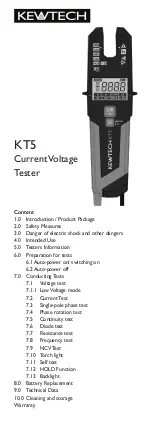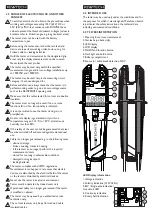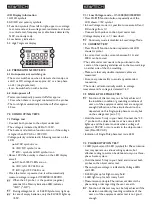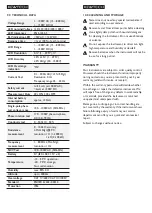
7.5 CONTINUITY TEST L RX
Make sure the object under test is not live.
• Connect both test probes to the object under test.
• Continuity is shown by the lighting up of the continuity
LED and a sound if resistance is below 500 kOhm.
• If a lower threshold for continuity is preferred, low
continuity mode can be selected.
· Press Torchlight-function button repeatedly until
the LRx symbol is shown on the LCD.
· Continuity is shown by the lighting up of the LED
and sound if resistance is below 20 Ohm.
The continuity test is performed automatically in
all modes except in Low Voltage and Resistance
mode.
The tester automatically switches to voltage
measurement if a voltage is detected >6 V - during
continuity testing.
7.6 DIODE TEST
Make sure the object under test is not live.
• Switch into diode testing mode by pressing On/Off-
function button repeatedly until
symbol is shown
on the LCD. Connect both test probes to the diode
under test.
The continuity LED lights and the buzzer sounds
when L1 is connected to the anode and L2 is
connected to the cathode.
Continuity indication will be off if L1 tip is
connected on Cathode of diode and L2 tip on
Anode.
Tester automatically switches to voltage
measurement if voltage >6 V or Single pole is
detected during diode testing.
7.7 RESISTANCE TEST
Make sure the object under test is not live.
• Switch into resistance measurement by pressing On/
Off-function button repeatedly until the k� symbol is
shown on LCD. Connect both test probes to the object
under test. Resistance up to 100 k� can be shown on
LCD. For resistance less than ~20� buzzer sounds
continuously to indicate low continuity.
Tester automatically switches to voltage measurement if
voltage >15 V or Single Pole is detected.
7.8 FREQUENCY TEST
• Switch into frequency measurement by pressing the On/
Off-function button repeated until Hz symbol is shown
on the LCD. Connect both test probes to the AC
voltage under test. Frequency from 1 Hz to 800 Hz can
be shown on LCD.
Frequency measurement is possible for voltages >10V AC.
The level of voltage will be shown only on bar graph
for voltages >120 V. ELV diode will indicate voltages
>50 V AC and >120 V DC.
7.9 CABLE BREAK DETECTION BY NCV
• Switch into NCV detection by pressing On/off-
function button repeatedly. LCD will show the NCV
symbol.
• The
NCV
function is used to find where the cable
breaks.
• Hold the voltage tester with the sensor against
the wire or cable. The voltage tester indicates the
strength of the signal digitally on the LCD screen.
• Store test probes safely to avoid any unintended
connection.
• Tester automatically switches to voltage measurement
if voltage >6 V or single pole is detected between
probes.
7.10 Torch light
• Press the “torchlight” button to turn on the light and
after approx. 30 s it will turn itself off.
7.11 Self test
• LEDs and all LCD segments and vibration motor,
torch light, ELV indication and buzzer are turned on
for a second after battery replacement.
Self test can be activated:
Shorting L1(-) and L2(+) probe tips while
device is turned OFF – leave device OFF for 30
seconds before shorting tips.
7.12 HOLD Function
• A long press (2 seconds) of the “torchlight/function”
button activates HOLD function and freezes display
value. With another quick press of the on “torchlight/
function” button freezing of display is released. When
the HOLD function is active symbol will be
shown on LCD.
7.13 Backlight
• White Backlight is turned on when torch light is
turned on.
8.0 BATTERY REPLACEMENT
Remove the probes from any testing point, when
opening the battery case. Batteries are dead
when the continuity test with both test probes
connected cannot be done anymore and the low
battery symbol is shown in the LCD.
Follow the procedure below and replace batteries
with new ones (type IEC LR03 1.5
V).
• Unscrew the battery door
• Pull out the battery door and replace the batteries.
Insert new batteries according to the engraving on
the battery door.
• Re-assemble battery door.
Confirm that the battery door case is properly
locked prior to measurements.







